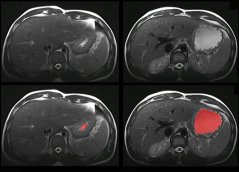
Project
Separating orosensory and gastric contributions to satiation and satiety
Wageningen University is part of the Nudge-it consortium, a group of leading institutions focusing on food choice research in the broadest sense possible. Nudge-it is a truly inter-disciplinary project. Partners’ experience encompasses neurobiology, neuroimaging, computational modelling, economics and public policy. At Wageningen University, research will focus on separating orosensory and gastric contributions to satiation and satiety using fMRI.
In this research we will use MRI scans of the stomach to see how much food is in the stomach. An example of this can be seen in the image below.

The figure shows four slices giving a view of a cross-section of a subject lying on his back at about the lowest point of the rib-cage. On the top left is the ‘empty’ stomach of a subject who has fasted for over 3 hours. We have made the stomach content red in the lower left version. On the right is the same subject, after the ingestion of a 500mL shake. We can really see the increase in stomach content in this slice. In order to calculate the total gastric volume, we calculate surface area in all slices and use this with the distance of the slices to calculate the volume.
Our goal is to couple this gastric data to perfusion fMRI scans of the brain, in order to visualize brain activation related to stomach activity.
This will allow us to understand the relative contributions of the stomach and tasting in the mouth when it comes to ingestive behavior. Our hope is that better understanding the process of satiation and satiety will help in creating new ideas to fight obesity.
More research: Food-Gut-Brain interplay